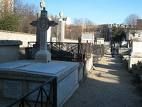Picpus
Sitting on the metro the other day, my eyes fell upon the station name Picpus, and I thought, 'what a great name for a cat'. Then, another thought - 'and how strange it is. I wonder where it comes from'. And thus, this evening, I did a little research and would like to share my discovery with you.
Around 1575, the rue de Picpus was a road crossing the land ('territoire') of Pique-Puce (literally meaning  'Flea-Bite'). The Lazare brothers thought the etymology came from an epidemic which presented itself as a rash similar to insect bites. It was treated miraculously by a monk who came to live in the village. The village became known as Pique-Puce, and extended from the Porte de Picpus north to Charonne. How about that. Not such a great name for a cat after all, then!
'Flea-Bite'). The Lazare brothers thought the etymology came from an epidemic which presented itself as a rash similar to insect bites. It was treated miraculously by a monk who came to live in the village. The village became known as Pique-Puce, and extended from the Porte de Picpus north to Charonne. How about that. Not such a great name for a cat after all, then!
 There's more. At 35, rue de Picpus (metro: Nation) in the 12th arrondissement, you can find Picpus Cemetery. You know how I love cemeteries, so you can imagine how I just had to find out more. Pay attention! From June 14th to July 27th, 1794 (during the Reign of Terror when those brought before the Revolutionary Tribunal were systematically executed), bloodstained carts shuttled back and forth between the guillotine on Place de la Nation and a rectangular, hastily-dug grave in a field near the disused convent of Augustinian canonesses. These grim trips lasted seven weeks. 1,306 people were beheaded and 'escorted' to Picpus, a place originally intended for a more light-hearted purpose. The massacre ended when Robespierre himself was beheaded.
There's more. At 35, rue de Picpus (metro: Nation) in the 12th arrondissement, you can find Picpus Cemetery. You know how I love cemeteries, so you can imagine how I just had to find out more. Pay attention! From June 14th to July 27th, 1794 (during the Reign of Terror when those brought before the Revolutionary Tribunal were systematically executed), bloodstained carts shuttled back and forth between the guillotine on Place de la Nation and a rectangular, hastily-dug grave in a field near the disused convent of Augustinian canonesses. These grim trips lasted seven weeks. 1,306 people were beheaded and 'escorted' to Picpus, a place originally intended for a more light-hearted purpose. The massacre ended when Robespierre himself was beheaded.
In 1797, the garden was sold in secret to Princess Amélie Zéphyrine de Salm-Kyrburg (wife of Aloys Antoine de Hohenzollern-Sigmaringen http://fr.wikipedia.org/wiki/Hohenzollern...yes, indeed, they were the great-grandparents of King Carol I of Roumania - the connections keep me happy!) whose brother Frédéric II of Salm-Kyrburg, executed during the Revolution, had been buried there.
A certain Mr. Coignard's plans to establish a convalescent home there later on ground to a halt when the garden was requisitioned and turned into a mass grave. Despite residents' protests, a wall was knocked down to enable the carts to get through more easily. The site was located at the far end of a plot of land so as to avoid attracting too much attention. Well...understandably.
 This was the final resting place of the cream of aristocracy as well as of minor nobility and a great many commoners, 702 to be exact. The rest of the land fell into disuse, and, in 1803, was bought by families of those who had been victims of the guillotine. They founded a second cemetery next to the mass graves. A commitee was founded, 'La Société de Picpus'. Even today, only descendants of the victims can claim to be buried at Picpus. One can also find commemorative plaques in memory of members of these families who were deported and died in the camps during the Second World War.
This was the final resting place of the cream of aristocracy as well as of minor nobility and a great many commoners, 702 to be exact. The rest of the land fell into disuse, and, in 1803, was bought by families of those who had been victims of the guillotine. They founded a second cemetery next to the mass graves. A commitee was founded, 'La Société de Picpus'. Even today, only descendants of the victims can claim to be buried at Picpus. One can also find commemorative plaques in memory of members of these families who were deported and died in the camps during the Second World War.
 Gilbert du Motier de La Fayette (French general, politician, character of the French
Gilbert du Motier de La Fayette (French general, politician, character of the French Revolution and hero of the American war of Independence, see http://fr.wikipedia.org/wiki/La_Fayette ) was buried there next to his wife Marie-Adrienne de Noailles, whose family was almost entirely wiped out during the Reign of Terror. The American national colours pay tribute to the heroes of the US War of Independence, undoubtedly the only American flag to fly in Paris without a break since 1834, including the years of the German occupation.
Revolution and hero of the American war of Independence, see http://fr.wikipedia.org/wiki/La_Fayette ) was buried there next to his wife Marie-Adrienne de Noailles, whose family was almost entirely wiped out during the Reign of Terror. The American national colours pay tribute to the heroes of the US War of Independence, undoubtedly the only American flag to fly in Paris without a break since 1834, including the years of the German occupation.
So...interesting, huh. I hadn't imagined the name Picpus would be so fascinating!
Tomorrow, I'll check out Ourcq, another odd name, simply because it reminds me of the Roumanian for 'Bear'! God bless Marcel!
Sleep well, toate lumea,
Love, Sarah xox

/https%3A%2F%2Fstorage.canalblog.com%2F33%2F16%2F508287%2F95344135_o.jpg)
/https%3A%2F%2Fstorage.canalblog.com%2F52%2F26%2F508287%2F95342137_o.jpg)
/https%3A%2F%2Fstorage.canalblog.com%2F42%2F99%2F508287%2F95342518_o.jpg)
/https%3A%2F%2Fstorage.canalblog.com%2F97%2F52%2F508287%2F55786848_o.jpg)
/https%3A%2F%2Fstorage.canalblog.com%2F33%2F68%2F508287%2F55786597_o.jpg)

/https%3A%2F%2Fstorage.canalblog.com%2F40%2F91%2F508287%2F98712362_o.jpg)
/https%3A%2F%2Fstorage.canalblog.com%2F38%2F76%2F508287%2F83379594_o.jpg)
/https%3A%2F%2Fstorage.canalblog.com%2F06%2F96%2F508287%2F83377251_o.jpg)
/https%3A%2F%2Fstorage.canalblog.com%2F92%2F69%2F508287%2F69301410_o.jpg)